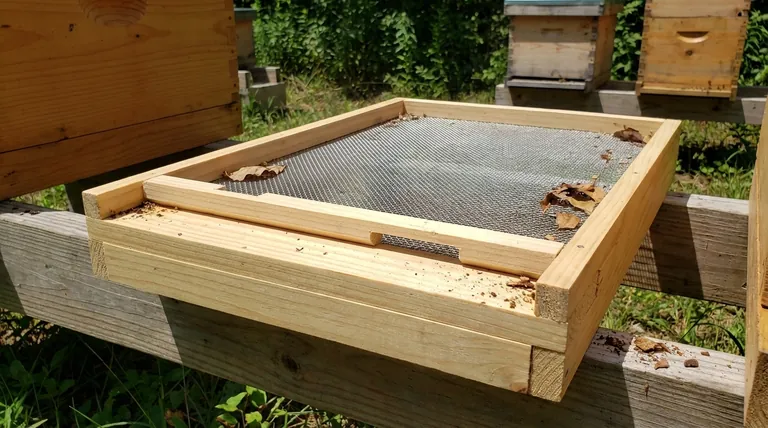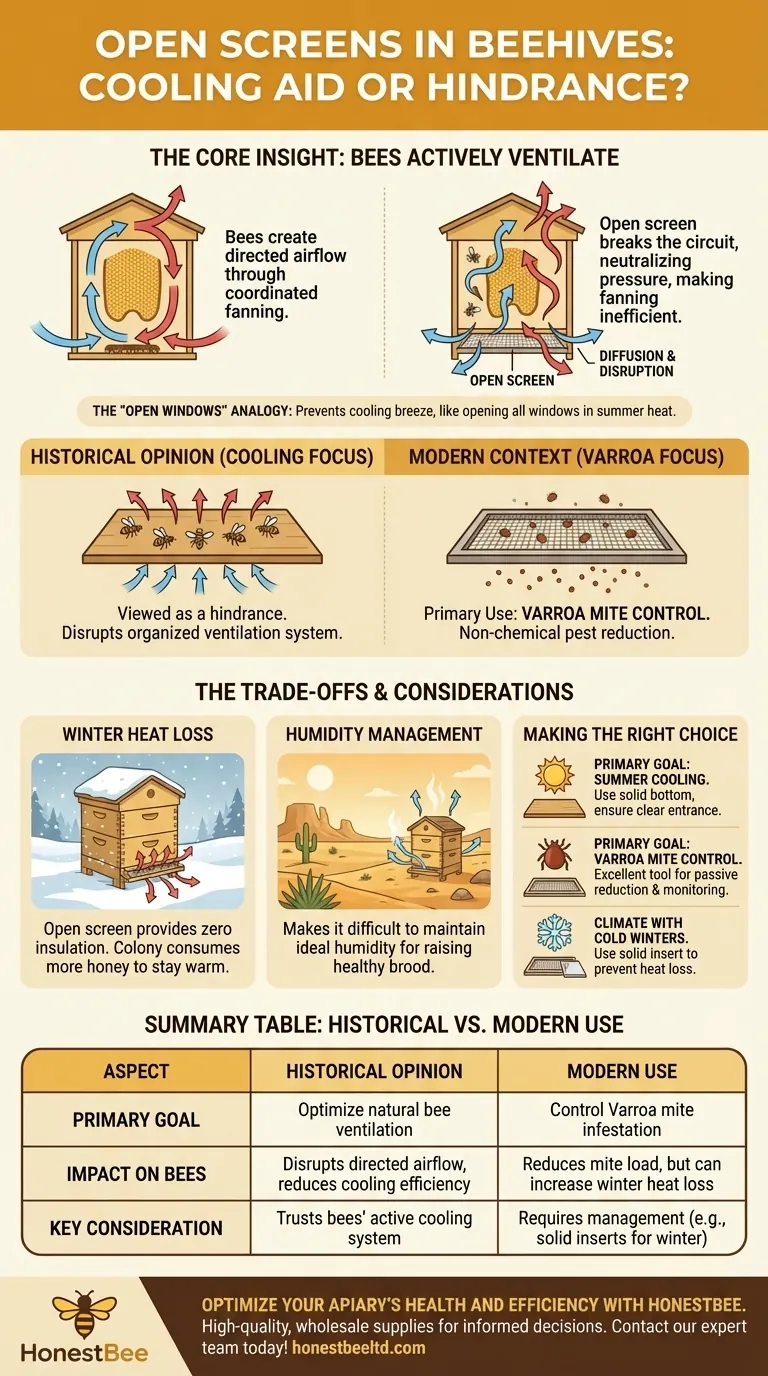Contrary to what might seem intuitive, the general opinion among beekeepers was that providing a hive with a large open screen is a hindrance, not a help, to the bees' efforts to cool their colony. The thinking was that it disrupts their highly organized system of ventilation, making their work much less effective during intense heat.
The core insight is that bees don't passively cool their hive; they actively ventilate it. An open screen breaks the directed airflow circuit they create, undermining their ability to efficiently exhaust hot, moist air.

The Principle: Directed Airflow vs. Passive Diffusion
Bees are master architects of their internal environment. Their cooling strategy is not based on simply letting hot air out, but on creating a powerful and precise air current.
The "Open Windows" Analogy
The common comparison was to opening all the windows and doors of a house during a Texas summer without air conditioning. While it might seem like you are "airing it out," you are actually just letting the hot ambient air in everywhere, preventing any single fan from creating a cooling breeze.
An open screen bottom on a beehive was viewed in the same way. It allows outside air to diffuse into the hive from below, but it breaks the bees' engineered system.
How Bees Actually Ventilate
Honeybees cool the hive through coordinated fanning. A line of forager bees stands at the hive entrance, facing the same direction, and beats their wings in unison.
This synchronized effort creates a powerful current. They draw cooler, drier air in one side of the entrance and push hotter, more humid air out the other side. This creates a complete convection circuit that ventilates the entire hive cavity.
How an Open Screen Disrupts the System
An open screen bottom essentially pokes a giant hole in the floor of their ventilation channel. As the bees at the entrance work to create a directed current, air simply leaks in or out from the bottom.
This diffusion neutralizes the pressure differential the bees are trying to create. Their fanning becomes far less efficient at pulling air through the entire brood nest and honey supers, which is where cooling is needed most.
Understanding the Modern Context and Trade-offs
While the historical opinion focused purely on cooling efficiency, the modern use of screened bottom boards is driven by different priorities, creating a set of trade-offs every beekeeper must manage.
The Primary Modern Use: Varroa Mite Control
Today, the number one reason beekeepers use screened bottom boards has nothing to do with temperature. It is a critical tool for Integrated Pest Management (IPM) against the Varroa destructor mite.
Mites that fall off a bee drop through the screen and out of the hive, unable to climb back up and re-infest another bee. This provides a non-chemical method of reducing the mite load within a colony.
The Downside in Winter
The greatest trade-off of a screened bottom is heat loss during winter. An open screen provides zero insulation from below, forcing the winter cluster to consume significantly more honey stores to generate the heat needed for survival.
Many beekeepers in colder climates use solid inserts, often called "bottom boards" or "Varroa trays," to close off the screen during the fall and winter months.
The Impact on Humidity
Bees don't just manage temperature; they also manage humidity, which is critical for raising healthy brood. An open screen can make it more difficult for the colony to maintain the ideal humidity levels, especially in very arid climates.
Making the Right Choice for Your Goal
Ultimately, whether to use an open screen depends entirely on your primary management goal.
- If your primary focus is helping bees cool in the summer: Trust their natural ability. Ensure they have a clear entrance and a nearby water source, as they also use evaporative cooling inside the hive. A large screen is not the best tool for this specific job.
- If your primary focus is Varroa mite management: A screened bottom board is an excellent tool for passively reducing mite loads and for conducting mite-drop counts to assess infestation levels.
- If you are in a climate with cold winters: Plan to use a solid insert with your screened bottom board to prevent excessive heat loss and help your colony conserve its vital winter stores.
By understanding how bees engineer their own environment, you can make management decisions that support their natural and highly effective systems.
Summary Table:
| Aspect | Historical Opinion (Cooling Focus) | Modern Use (Varroa Focus) |
|---|---|---|
| Primary Goal | Optimize natural bee ventilation | Control Varroa mite infestation |
| Impact on Bees | Disrupts directed airflow, reduces cooling efficiency | Reduces mite load, but can increase winter heat loss |
| Key Consideration | Trusts bees' active cooling system | Requires management (e.g., solid inserts for winter) |
Optimize Your Apiary's Health and Efficiency with HONESTBEE
Understanding the delicate balance between bee biology and hive management is key to a thriving apiary. Whether your priority is supporting natural ventilation or implementing effective Varroa mite control strategies, having the right equipment is essential.
HONESTBEE supplies commercial apiaries and beekeeping equipment distributors with the high-quality, wholesale-focused supplies needed to make informed decisions. From screened bottom boards with winter inserts to other essential beekeeping equipment, we provide the tools for success.
Let us help you support your bees' natural systems effectively. Contact our expert team today to discuss your specific needs and explore our product catalog.
Visual Guide

Related Products
- Langstroth Screen Bottom Board for Beekeeping Wholesale
- Australian Pine Wood Langstroth Screen Bottom Board for Wholesale
- HONESTBEE Wooden Bee Escape Board with Triangle Mesh Design for Beekeeping
- Professional Engraved Round Hive Number Tags for Beekeeping
- Professional Galvanized Hive Strap with Secure Locking Buckle for Beekeeping
People Also Ask
- What are some considerations when choosing between solid and screened bottom boards? Optimize Hive Health & Pest Control
- What are the benefits of using a screened bottom board in warm or humid climates? Boost Hive Health & Control Pests
- What is the primary function of a screened bottom board in a hive? Enhance Ventilation & Control Varroa Mites
- What are the advantages of a screened bottom board? Boost Hive Health with Superior Ventilation & Pest Control
- What are the benefits of a screened bottom board? Boost Hive Health & Control Varroa Mites



















